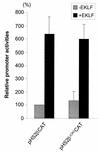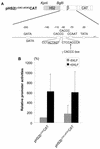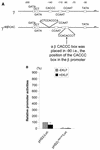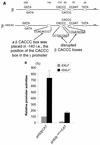Activation of beta-globin promoter by erythroid Krüppel-like factor
- PMID: 9418858
- PMCID: PMC121459
- DOI: 10.1128/MCB.18.1.102
Activation of beta-globin promoter by erythroid Krüppel-like factor
Abstract
Erythroid Krüppel-like factor (EKLF), an erythroid tissue-specific Krüppel-type zinc finger protein, binds to the beta-globin gene CACCC box and is essential for beta-globin gene expression. EKLF does not activate the gamma gene, the CACCC sequence of which differs from that of the beta gene. To test whether the CACCC box sequence difference is the primary determinant of the selective activation of the beta gene by EKLF, the CACCC boxes of beta and gamma genes were swapped and the resulting promoter activities were assayed by transient transfections in CV-1 cells. EKLF activated the beta promoter carrying a gamma CACCC box at a level comparable to that at which it activated the wild-type beta promoter, whereas EKLF failed to activate a gamma promoter carrying the beta CACCC box, despite the presence of the optimal EKLF binding site. Similar results were obtained in K562 cells. The possibility that overexpressed EKLF superactivated the beta promoter carrying the gamma CACCC box, or that EKLF activated the mutated beta promoter through the intact distal CACCC box, was excluded. To test whether the position of the CACCC box in the beta or gamma promoter determined EKLF specificity, the proximal beta CACCC box sequence was created at the position of the beta promoter (-140) which corresponds to the position of the CACCC box on the gamma promoter. Similarly, the beta CACCC box was created in the position of the gamma promoter (-90) corresponding to the position of the CACCC box in the beta promoter. EKLF retained weak activation potential on the beta(-140CAC) promoter, whereas EKLF failed to activate the gamma(-90betaCAC) promoter even though that promoter contained an optimal EKLF binding site at the optimal position. Taken together, our findings indicate that the specificity of the activation of the beta promoter by EKLF is determined by the overall structure of the beta promoter rather than solely by the sequence of the beta gene CACCC box.
Figures










References
-
- Ausubel F M, Brent R, Kingston R E, Moore D D, Seidman J G, Smith J A, Struhl K, editors. Current protocols in molecular biology. New York, N.Y: John Wiley & Sons, Inc.; 1994.
-
- Bieker J J. Role of erythroid Krüppel-like factor (EKLF) in erythroid-specific transcription. In: Stamatoyannopoulos G, editor. Molecular biology of hemoglobin switching. Andover, United Kingdom: Intercept; 1995. pp. 231–241.
Publication types
MeSH terms
Substances
Grants and funding
LinkOut - more resources
Full Text Sources
